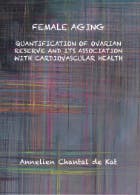Annelien de Kat
Female Aging - Quantification of ovarian reserve and its association with cardiovascular health

- Datum
- (Co) promotoren
- 11-05-2017
- prof.dr. F.J.M. Broekmans, prof.dr.ir Y.T. van der Schouw
Samenvatting
Introduction As women age, they experience changes in their reproductive physiology. This thesis aimed to provide more insight into reproductive health changes of the aging woman by addressing two questions: 1) Can knowledge of individual anti-Müllerian hormone (AMH) decline improve the prediction of time to menopause; 2) Is there a relationship between ovarian and cardiovascular aging? Quantification of ovarian reserve decline Anti-Müllerian hormone is an ovarian reserve marker, i.e. levels of circulating AMH are related to the number of remaining oocytes. Despite the fact that levels of AMH are associated with time to menopause, to date prediction of individual age at menopause is still unreliable. Furthermore, individual AMH decline patterns and the added value of AMH changes to age at menopause prediction have not previously been studied. In a population-based cohort of 3,326 women of the Doetinchem Cohort Study (DCS), AMH levels were measured every 5 years over 20 years. At baseline, the mean age was 40 ± 10 years. On average, 87% of the AMH levels of individual women remained comparatively low or high with age. Rather than declining in parallel, individual AMH decline trajectories converged to one another, meaning that absolute differences between high and low age-specific AMH levels decreased with age. In the DCS, AMH decline trajectories of the 2,434 premenopausal women were related to age at menopause. For a 25-year-old woman, knowledge of her AMH decline rate between the ages 20-25 could improve the accuracy of her age at menopause prediction by 5%, whereas the prediction of early menopause (≤45 years) was not improved. Individual AMH decline thus provided little improvement to age at menopause prediction and the relatively low discriminative ability (C-statistics <0.78) furthermore argues against the use of AMH decline trajectories as a screening method for early menopause. The relationship between ovarian and cardiovascular aging Menopause is related to CVD risk, but the mechanisms that govern this relationship have not been fully elucidated. It is challenging to separate the relationship of chronological aging from reproductive aging to CVD risk, as postmenopausal women are generally older than premenopausal women. In the cross-sectional population-based Lifelines Cohort, CVD risk factors were compared between 63,466 age-matched women in various menopausal stages. For women aged between 46-55 years, total cholesterol (TC) and LDL-cholesterol (LDL-c) levels were up to 0.4 mmol/L and 0.3 mmol/L higher in postmenopausal compared to premenopausal women, respectively. Compared to postmenopausal women at 45 years, TC and LDL-c levels were 0.5 and 0.4 mmol/L higher in postmenopausal women aged 50 years. In the DCS, premenopausal AMH levels <0.16 ng/mL were associated with 0.11 (95% CI 0.02;0.21) more metabolic risk factors compared to AMH levels ≥0.16 ng/mL. Furthermore, each ng/mL lower logAMH level was associated with a 21% (95% CI 1.04;1.37) higher risk of CVD occurrence and each additional ng/mL/year decrease of logAMH was associated with a 46% (95% CI 1.14-1.87) higher risk of CVD occurrence. Thus, both chronological and reproductive aging are associated with CVD risk factors and ovarian aging is associated with CVD occurrence.
